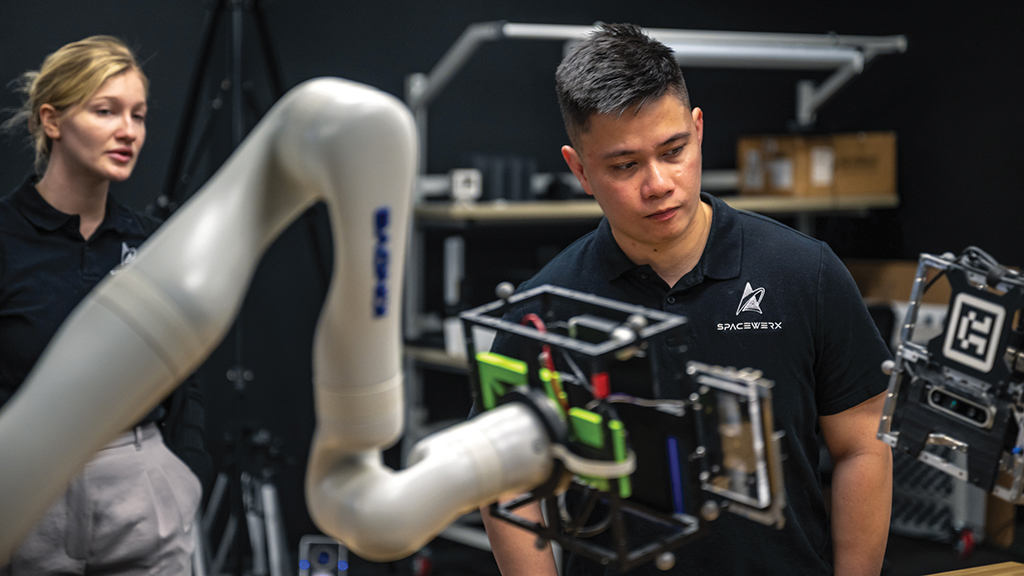This article is published in Aviation Week & Space Technology and is free to read until May 24, 2025. If you want to read more articles from this publication, please click the link to subscribe.

The TRL Bootcamp helps space startups prepare their products for military use cases.
The U.S. Space Force and The Aerospace Corp. have completed the first iteration of a new program meant to bridge cutting-edge commercial technology and government use cases.
The Technology Readiness Level (TRL) Bootcamp launched in 2024 and is directed by the service’s technology investment arm, SpaceWerx. Its first cohort had access to varying levels of technical expertise from The Aerospace Corp. and to the organization’s facilities. Companies that had won specific Small Business Innovation Research (SBIR) contracts were invited to participate at no further cost. The first cohort was focused on in-space servicing, assembly and manufacturing.
- TRL varies depending on mission and application
- Participating companies valued the in-depth technical reviews
Seven companies were selected from a broader group of recent SBIR awardees to participate: Arkisys, CisLunar Industries, iMetalX, Kall Morris Inc. (KMI), ThermaSat, Turion Space and Wallaroo Labs.
SpaceWerx runs the TRL Bootcamp with funds provided by the Space Force and internal SBIR administrative resources, the office says.
During the bootcamp, The Aerospace Corp. opened its doors to participating companies to engage with its subject-matter experts on topics of their choosing or to bring their products into one of the organization’s facilities, such as its Collaborative and Autonomous Vehicles Ecosystem (CAVE) Lab. At the end of the sessions, which ranged from three to six months, The Aerospace Corp. provided a TRL assessment to both the company and the government.
The definition of technology readiness is mission- and application-dependent, Brian Bone, principal director of commercial space futures at The Aerospace Corp., told Aviation Week at the Space Foundation’s annual Space Symposium here. When commercial companies bring their products to the organization for assessment, they might be rated at a lower TRL for government use than for a purely commercial case.
The TRL Bootcamp is meant to help “close that gap for a military use case,” Bone said.

Companies that opted into the program wanted to take advantage of the expertise at The Aerospace Corp. to help verify their products for the government ecosystem.
KMI co-founder and CEO Troy Morris was impressed with the depth of The Aerospace Corp. team’s research and review of his company’s multi-armed robotic device, the Responsive Engaging Arms for Captive Care and Handling (Reacch). “That diligence of their deep dive into our technology was internally rewarding,” he says.
CisLunar Industries, which is developing products for use in recycling defunct spacecraft and debris metals in space, asked The Aerospace Corp. team to assess its space foundry’s ability to manufacture a specific type of propellant rod. CisLunar Chief Operating Officer Lee Steinke participated in four meetings with The Aerospace Corp. experts, she tells Aviation Week.
After those meetings, CisLunar has more clarity about how to develop its foundry’s concepts of operations to build those propellant rods, she says.
Others joined the bootcamp with broader questions. Arkisys, a Southern California-based startup working on robotic satellite assembly, sought support in honing its wider technology architecture and discovering potential gaps in its plan, CEO David Barnhart says.
The bootcamp appeared to be more useful for companies seeking to define the TRL level of space-bound hardware but was less applicable to larger questions at a higher architectural level, he notes.
While the bootcamp is geared to move at a clipped pace, some companies’ experiences were slowed by bureaucratic elements of the onboarding process. For example, when KMI applied to participate, it was particularly eager to book time in The Aerospace Corp.’s facilities. But KMI was unable to coordinate a time to visit the CAVE Lab once its onboarding process was completed because by then the Reacch arm was on its way to launch to the International Space Station for several in-space demonstrations, Morris says.
The TRL Bootcamp team is still honing its methods of measuring success, but it is considering such developments as follow-on contracts for additional work, Bone said.
The next cohort will begin in the summer, he said. It comprises four undisclosed companies focused on tactically responsive space missions.





